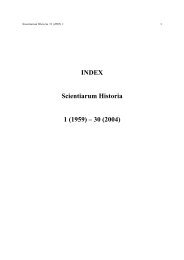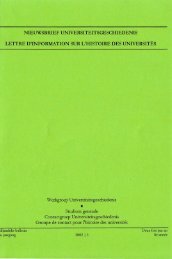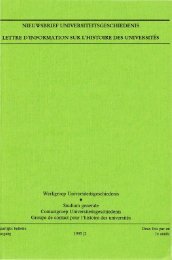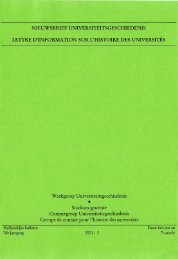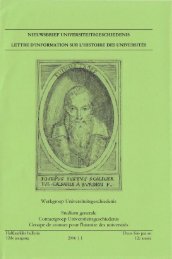the ocular harpsichord of louis-bertrand castel - Gewina
the ocular harpsichord of louis-bertrand castel - Gewina
the ocular harpsichord of louis-bertrand castel - Gewina
You also want an ePaper? Increase the reach of your titles
YUMPU automatically turns print PDFs into web optimized ePapers that Google loves.
Castel's <strong>ocular</strong> <strong>harpsichord</strong> 45<br />
<strong>the</strong>y could see a slight purple before <strong>the</strong> red. Next he introduced, out <strong>of</strong> <strong>the</strong><br />
blue, a comparison between <strong>the</strong>se colours and <strong>the</strong> musical scale in C major,<br />
"because <strong>the</strong> colours can be equally well expressed in numbers as <strong>the</strong> tones are".<br />
As <strong>the</strong> fundamental tone, however, he took purple and not red (which was a<br />
second above <strong>the</strong> root) since<br />
by raising <strong>the</strong> violet enough, one arives at a new purple, just like in rising along with <strong>the</strong> tones<br />
one gets from B to C which is an octave higher than <strong>the</strong> original C. And since in music this<br />
note is given <strong>the</strong> same name because <strong>of</strong> <strong>the</strong>ir ressemblance, it is <strong>the</strong> same with <strong>the</strong> colours,<br />
which, after having risen by <strong>the</strong> interval <strong>of</strong> an octave, recover <strong>the</strong> same names; or ra<strong>the</strong>r, two<br />
colours, just like two tones, one <strong>of</strong> which has exactly twice <strong>the</strong> number <strong>of</strong> vibrations as <strong>the</strong><br />
o<strong>the</strong>r, are taken to be <strong>the</strong> same colour and carry <strong>the</strong> same name.*'<br />
Although no-one had succeeded in actually measuring <strong>the</strong> rates <strong>of</strong> vibrations <strong>of</strong><br />
<strong>the</strong> various spectral colours, Euler thus not only supposed <strong>the</strong> rate for violet to<br />
be nearly twice as great as <strong>the</strong> rate for red, but believed as well, and in this he<br />
was wholly original, that <strong>the</strong>re existed higher and lower octaves <strong>of</strong> <strong>the</strong> same<br />
colours.**<br />
It was on this principle, Euler said, that Castel had imagined a kind <strong>of</strong> music<br />
<strong>of</strong> colours and had deviced his <strong>ocular</strong> <strong>harpsichord</strong>, which he presumed <strong>the</strong><br />
princess "had heard talked about on several occasions". It seems Euler in a way<br />
"rationally reconstructed" Castel's ideas within his own <strong>the</strong>ory, discarding<br />
completely Castel's own chromatic scale. This did not, however, affect his<br />
appreciation <strong>of</strong> <strong>the</strong> performance <strong>of</strong> <strong>the</strong> <strong>harpsichord</strong> itself, since he doubted<br />
whe<strong>the</strong>r "showing various pieces <strong>of</strong> cloth dyed in different colours would be very<br />
agreeable". According to Euler it was painting "that to <strong>the</strong> eyes is <strong>the</strong> same thing<br />
as music is to <strong>the</strong> ears".^ Never<strong>the</strong>less, later German authors on natural<br />
philosophy who accepted Euler's <strong>the</strong>ory ra<strong>the</strong>r than Newton's tended to bring in<br />
Cited in Euler, Lettres, vol. 11, p. 74 (Letter 31): "puisque les couleurs aussi bien que les sons<br />
se peuvent exprimer en nombres"; "haussant davantage le violet, on revient a un nouveau pourpre,<br />
tout comme en monlant dans les sons, on parvient au dcla de B au son c, qui est un octave audessus<br />
de C. Et comme dans la musique on donne a ce ton le meme nom a cause de leur<br />
ressemblance, il en est de meme dans les couleurs, qui apres avoir monte par I'intervalle d'une<br />
octave, recouvrent les memes noms: ou bien deux couleurs, comme deux tons dont le nombre de<br />
vibrations de I'une est precisement le double de I'autre, passent pour la meme couleur, et ont le<br />
meme nom."<br />
See Hakfoort, Optica, pp. 90-113, on Euler's <strong>the</strong>ory. Of course <strong>the</strong> frequency <strong>of</strong> blue light is<br />
in fact roughly twice as great as <strong>the</strong> frequency <strong>of</strong> red light, but this is purely coincidental.<br />
Idem: "Pour moi je pense que c'est plutot la peinture, qui est par rapport aux yeux la meme<br />
chose que la Musique aux oreilles; et je doute fort qu'une representation de plusieurs morceaux de<br />
draps teints de diverses couleurs, puisse etre fort agreable." If he had not already learned about<br />
Castel's <strong>harpsichord</strong>, he would have from a letter by Krafft, discussing <strong>the</strong> St Petersburg Academy<br />
session <strong>of</strong> 1742. See A.P. Juskevii^ & E. Winter, ed.. Die Berliner und die Peiersburger Akademie der<br />
Wissenschafien im Briefwechsel Leonhard Eulers (Berlin [Ost], 1959-1976), vol. 3, pp. 137-138.






